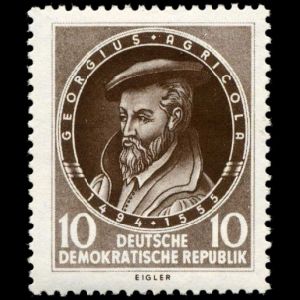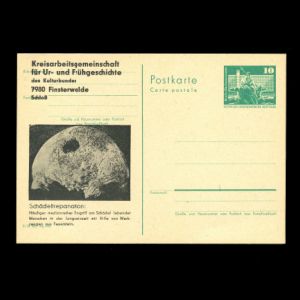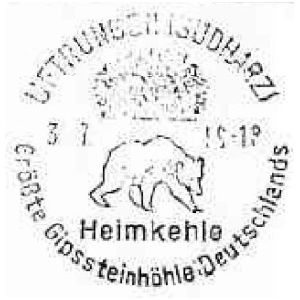the place where Paleontology and Paleoanthropology meets Philately
German Democratic Republic (GDR)
Dinosaurs and other prehistoric animals, fossils, contributors to
Paleontology and Paleoanthropology science, Charles Darwin
on stamps, postmarks and postal stationeries of German Democratic Republic
| << previous country | back to index | next country >> |
Contents:
- Country Overview
- Philately of East Germany
- Official stamps of East Germany related to Paleontology or Paleoanthropology
- Other stamps of East Germany to consider: contributors to Paleontology or Paleoanthropology
- Post stationery of East Germany related to Paleontology and Paleoanthropology
- Postmarks of East Germany related to Paleontology and Paleoanthropology
- Other postmarks of East Germany to consider
- References
- Acknowledgements
In 1989, numerous social and political forces in the GDR and abroad led to the destruction of the Berlin Wall and the emergence of a government committed to liberalization. The following year open elections were held, and international negotiations led to the signing of the Final Settlement treaty on the status and borders of Germany. The GDR was dissolved and Germany was unified on 3 October 1990. [R1]
With the formation of the German Democratic Republic (GDR) the Deutsche Post of the GDR service was established as the governmental agency to provide mail services. Its first stamp was released on October 9, 1949. Stamps were to some degree used to gain currency abroad, that is some stamps were not produced for circulation but sold directly to stamp dealers. With the 1990 reunification, the Deutsche Post became part of the Deutsche Bundespost. [R2]
Official stamps of East Germany related to Paleontology: dinosaurs and other prehistoric animals, fossils, Charles Darwin
| 19.06.1958 "Famous naturalists" [1] | 06.02.1973 "Berlin Natural History Museum, Paleontologic collection" | 24.10.1978 "250th anniversary of Dresden Science Museum" [2] |
 |
 |
 |
| 17.04.1990 "100th anniversary of Natural History Museum of Humboldt University in Berlin" [3] | ||
 |
|
|
Notes:
[1] Charles Darwin shown on the green stamp and Carl Linnaeus shown on the red one.
[2] Frog, Palaeobatrachus diluvianus, fossil shown on stamp with face value of 35pf. Palaeobatrachus was a genus of primitive frog from Europe that existed from the Cretaceous to the middle Pleistocene period (621-568 thousand years ago).
P.S. There are only few stamps and postmarks of prehistoric frogs.
[3] The only dinosaur stamps of East Germany.
The stamp depicting Kentrurosarus was issued in two formats: a sheet of the stamp and as a souvenir sheet with a block of four stamps. The margins of the souvenir sheet had depictions of may marine prehistoric animals on the margins. The other issues in the set were also issued in sheets of the single variety.
Originally designed as a three-winged building according to the plans of August Tiede, it was opened in 1889 and brought together three previously independent institutions of the University of Berlin: the Geological-Paleontological, the Mineralogical-Petrographic and the Zoological Museum (established in 1809).
Too date The Museum contains over 30 million objects.
One of the most famous dinosaur skeletons in the Museum’s collection is the skeleton of Brachiosaurus brancai, shown on the stamp with face value of 50 pf.

|

|
| "Mounted skeleton of Brachiosaurus in dinosaur hall of Natural History Museum in Berlin on post card of Germany 2010. | Brachiosaurus skeleton on stamp of East Germany 1990. MiNr.: 3327, Scott: 2815 |
This fossil was originally collected between 1909 and 1912 by German paleontological expeditions in the Tendaguru Formation of Tanzania (Tanzania was a colony of Germany at that time).
In 1914 German paleontologist Werner Janensch described is as new dinosaur species of Brachiosaurus genus - Brachiosaurus brancai.
In 2009 Brachiosaurus brancai was assigned to a new genus Giraffatitan.
Since its discovery and till 1990s, Giraffatitan was claimed to be the largest dinosaur known, (ignoring the possibly larger but lost Maraapunisaurus) and thus the largest land animal in history. All size estimates for Giraffatitan are based on the skeleton mounted in Berlin, which is partly constructed from authentic bones. [R3]
Other stamps of East Germany to consider: contributors to Paleontology
| 02.11.1955 "400 years since death of Georgius Agricola" [A1] | 26.02.1980 "Famous scientists" [A2] | |
 |
 |
|
Notes:
[A1] Georgius Agricola was fossil collector and also known as "the father of mineralogy".
[A2] Alfred Wegener shown on stamp with face value of 25pf
Postal stationery of East Germany related to Paleontology and Paleoanthropology: Neanderthal, fossils, contributors to Paleontology and Paleoanthropology science
| 1982 "Charles Darwin" [PS1] | 1983 "100th anniversary of Museum of Prehistory and Early History of Thuringia" [PS2] | 1990 "Human Evolution" |
 |
 |
 |
Notes:
[PS1] 100 years since death of Charles Darwin. Tree of life and quote from his most famous book "Origin of Species by Means of Natural Selection". There is also a commemorative postmark with portrait of young Darwin issued for this event.
[PS2] Exhibits of Museum of Prehistory and Early History of Thuringia explain the 400.000 year history of the region, includes remains of Neanderthals and their flint tools, as shown on illustration of the postcard.
Other Postal stationery of East Germany to consider: flint tool, contributors to Paleontology and Paleoanthropology science
| 1982 "Flint tool" [PSA1] | 198x "Prehistoric medicine" | 1984 "Thomas Henry Huxley" |
 |
 |

|
Notes:
[PSA1] Flint tools shown on illustration of the postcard and correspondent postmark with slogan "Report Archaeological finds !"
[PSA2] "Cranial surgery". The text on the bottom-left side says-frequent medical intervention on the skull of living humans in the Jungsteinstein with the help of flint tools.
[PSA3] Thomas Henry Huxley (4 May 1825 – 29 June 1895) was an English biologist and anthropologist specializing in comparative anatomy. He is known as "Darwin's Bulldog" for his advocacy of Charles Darwin's theory of evolution. Some animals and human skulls are shown on the postcard too.
Postmarks of East Germany related to Paleontology and Paleoanthropology: prehistoric animals, fossil, Charles Darwin
Legend is here| 1963-1984 [DU] "Ruebelaender stalactite caves" [Sp] [C1] | 1971-1973 [DU] "Uftrungen the biggest gypsum cave in Germany" [Sp] [C1] | 1973-1990 [DU]
"Uftrungen gypsum cave in Germany" [Sp] [C1] Available in black and blue colors |
 |
 |
 |
| 27.11.1982 "Charles Darwin (1809-1882)" [Sp] [PS1] /sup> | 17.04.1990 "100th anniversary of Natural History Museum of Humboldt University in Berlin" [FDC] | |
 |
 |
|
Notes:
[C1] Fossils of Cave Bears found in many caves across Germany
Other Postmarks of East Germany to consider: flint tool, contributors to Paleontology and Paleoanthropology science
Legend is here| 28.05.1982 "Flint tool" | 09.01.1984 "Thomas Henry Huxley" | |
 |
 |
|
References:
- [R1] East Germany: Wikipedia WikiTravel
- [R2] Postal History and Philately of Georgia: Wikipedia
- [R3] Brachiosaurus and Giraffatitan
Acknowledgement:
Dr. Peter Voice from Department of Geological and Environmental Sciences, Western Michigan University, for reviewing the draft page and his valuable comments.
| << previous country | back to index | next country >> |